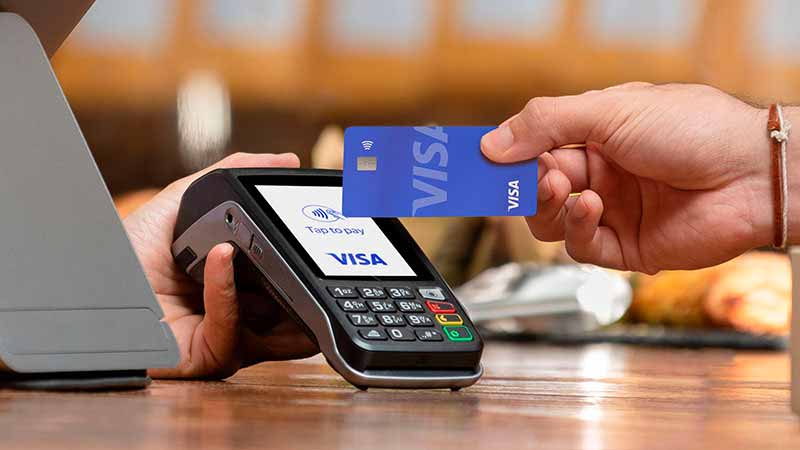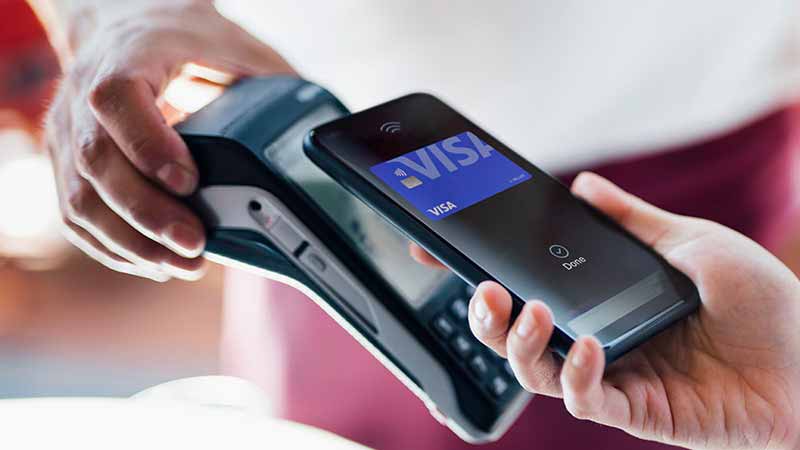What are contactless payments?
Contactless payments are transactions made by tapping either a contactless card or payment-enabled mobile or wearable device over a contactless-enabled payment terminal. Cards, phones, watches, and other devices use the same contactless technology. When you tap to pay checkout is secure and convenient.

Visa Contactless cards
If your Visa card features the Contactless Indicatoron either the front or back, you can use it to tap to pay where you see the Contactless Symbol at many of your favorite stores.

Devices
Don’t have a contactless card? You can still tap to pay by loading an eligible payment card into your payment-enabled phone or wearable device.
Reasons to love contactless payments
FAQ about contactless payments
-
-
Tapping to pay uses short-range wireless technology to make secure payments between a contactless card or payment-enabled mobile/wearable device and a contactless-enabled checkout terminal. When you tap your card or device near the Contactless Symbol, your payment is sent for authorization.
-
-
The EMVCo Contactless Indicator* indicates acceptance. When featured on a card, it means the card can be used to tap to pay. When featured on a checkout terminal or on store signage, it means a merchant accepts tapping to pay.
The EMVCo Contactless Symbol* indicates where you tap your contactless card or payment-enabled mobile/wearable device on the checkout terminal to make a payment.
-
-
You'll see the Contactless Indicator on your card.
-
-
The Wi-Fi-looking symbol on a debit or credit card is the EMVCo Contactless Indicator*. It indicates that your card can be used to tap to pay on a contactless-enabled payment terminal.
-
-
The RFID-looking symbol on a debit or credit card is the EMVCo Contactless Indicator*. It indicates that your card can be used to tap to pay on a contactless-enabled payment terminal.
-
-
Your contactless card or payment-enabled mobile/wearable device just needs to be within 1 to 2 inches of the Contactless Symbol to initiate a payment.
-
-
One to two seconds should do it.
-
-
No, actual tapping is not necessary.
-
-
It works best when your contactless card or payment-enabled mobile/wearable device is held flat over the Contactless Symbol , versus held at an angle.
-
-
Once you are prompted to pay (by the cashier, a light on the checkout terminal, etc.), place your contactless card or payment-enabled mobile/wearable device within 1 to 2 inches of the Contactless Symbol on the terminal and follow the prompts.
-
-
Tapping to pay with a Visa contactless card or payment-enabled mobile/wearable device is secure and convenient – perfect for places like fast-food restaurants, grocery stores, coffee shops, vending machines, taxis and more. Just look for the Contactless Symbol at checkout. Tapping to pay is secure because each transaction is accompanied by a one-time code, just like contact EMV. Unlike cash, tapping to pay provides an electronic record of your purchases and gives you all the great functionality and convenience of a Visa card.
-
-
Contact your bank by calling the number on the back of your card to inquire.
-
-
Contactless payments, including Visa contactless cards, Google Pay and Apple Pay, use the same NFC (Near Field Communication) technology. Samsung Pay, however, works with both NFC technology and MST (Magnetic Secure Transition) technology, which can be used anywhere you can swipe.
-
-
You can tap to pay where you see the Contactless Symbol on a checkout terminal. Millions of places around the world accept contactless payments, including fast-food restaurants, coffee shops, grocery stores, retail pharmacies, vending machines, taxis and more.
-
-
Yes. If you don’t see the Contactless Symbol on the checkout terminal, you can still swipe or insert your contactless card, just like any other Visa card.
-
-
Yes. You can tap to pay at millions of places around the world, wherever you see the Contactless Symbol. In countries like Australia, Canada, the UK and France, over half of retailers currently accept contactless payments. If tapping to pay is not available at a location, you can simply swipe or insert your Visa contactless card at checkout.
-
-
Yes. Here’s why:
- Each Visa contactless card carries the same trusted security as a Visa contact chip card.
- The one-time code generated every time a contactless card or payment-enabled mobile/wearable device is used at an in-store contactless-enabled terminal protects your payment information, making it extremely effective in reducing counterfeit fraud.
- You can’t pay accidentally—your contactless card or payment-enabled mobile/wearable device must be within 2 inches of the terminal for the transaction to take place. And you won’t be billed twice, even if you accidentally tap twice.
- Tapping to pay with your Visa contactless card or payment-enabled mobile/wearable device helps you avoid touching surfaces at checkout.
-
-
The contactless card or payment-enabled mobile/wearable device securely transmits information including the account number, expiration date, and a one-time code that changes for every in-person transaction. The code is different than the code encoded on the magnetic stripe of a Visa card.
-
-
Visa contactless transactions generate a one-time, transaction-specific code. Due to the nature of the code and additional fraud protection processes built into the Visa network, it is difficult to use skimmed cardholder information for fraudulent purchases. As a result, fraud from skimming is very unlikely and limited in scope. You can also rest assured that Visa cards offer protection from any unauthorized use with Visa’s Zero Liability Policy.
-
-
No. The technology behind tapping to pay requires the merchant to initiate the payment. Next, the contactless card or payment-enabled mobile/wearable device must be tapped or held within 2 inches of the contactless-enabled terminal in order for a transaction to take place.
-
-
No. Contactless-enabled checkout terminals will only communicate with one card at a time. If you have more than one contactless card in your wallet, you should tap the individual card you want to use, rather than tap you whole wallet.
-
-
If your Visa card is lost or stolen, or you believe there has been unauthorized activity on your account, contact your issuing bank or credit union immediately. If you don’t have that contact information readily available, contact Visa and we will be able to assist you.